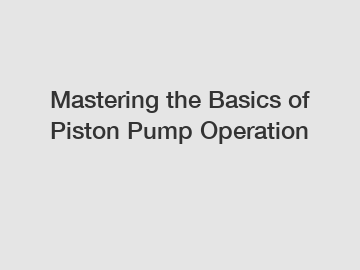Mastering the Basics of Piston Pump Operation
Mastering the Basics of Piston Pump Operation.
Piston pumps are essential components in many industrial and commercial applications. These versatile pumps are used in a wide range of industries, from oil and gas to manufacturing and agriculture. Understanding the basics of piston pump operation is crucial for ensuring the efficient and reliable performance of these pumps. In this article, we will explore the key principles of piston pump operation and provide tips for mastering their use.
What is a Piston Pump?

A piston pump is a type of positive displacement pump that uses one or more pistons to move fluid through a system. As the piston moves back and forth within a cylinder, it creates a vacuum and pressure cycle that draws fluid into the pump and then forces it out through a discharge port. This continuous cycle allows piston pumps to generate high pressures and deliver precise flow rates, making them ideal for applications that require accurate and consistent performance.
Operating Principles of Piston Pumps.
One of the key principles of piston pump operation is the reciprocating motion of the piston. This back-and-forth movement creates a pulsating flow of fluid, which can be managed through the use of valves and other control devices. By adjusting the stroke length, speed, and timing of the piston, operators can control the flow rate and pressure of the pump to meet the specific requirements of their application.
Another important aspect of piston pump operation is the sealing mechanism that prevents fluid from leaking out of the pump. Piston pumps typically use seals or packing to create a tight seal between the piston and cylinder walls. Proper maintenance and regular inspection of these seals are essential for preventing leaks and ensuring the long-term reliability of the pump.
Tips for Mastering Piston Pump Operation.
To master the operation of piston pumps, it is important to follow these key tips:
1. Understand the requirements of your application - Before using a piston pump, make sure to thoroughly understand the specific flow rate, pressure, and temperature requirements of your application. This will help you select the right pump and set it up for optimal performance.
2. Properly install and maintain the pump - Follow the manufacturer's guidelines for installing and operating the pump, and be sure to perform regular maintenance to keep the pump in good working condition. This includes checking and replacing seals, lubricating moving parts, and monitoring performance.
3. Monitor performance and make adjustments as needed - Keep an eye on the flow rate, pressure, and temperature of the pump during operation, and be prepared to make adjustments to the settings as needed. This will help you optimize the performance of the pump and avoid potential issues.
Mastering the basics of piston pump operation is essential for maximizing the efficiency and reliability of these essential components. By understanding the key principles of piston pump operation and following these tips, you can ensure smooth and consistent performance in your industrial or commercial application.
Contact Us.
If you have any questions or need assistance with mastering the basics of piston pump operation, feel free to contact us. Our team of experts is here to help you optimize the performance of your piston pump and ensure the success of your application.
If you are looking for more details, kindly visit pneumatic piston pump supplier, diaphragm pump failures, diaphragm pump troubleshooting.
204
0
0

Comments
All Comments (0)